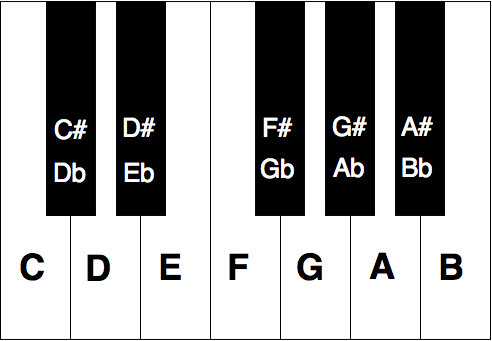This Piano Key Chart is a great tool for people just starting out learning the notes on the piano keyboard. Learning the keys and notes on the piano can be a difficult task for beginners, but using this chart will make the learning process much easier.
There are two different kinds of keys on the piano. There are black keys, and white keys. The white keys are called naturals and the black keys are called sharps and flats.
How to Read a Sharp and Flat
In music, a sharp is represented by a #, or number sign, and a flat looks like a lower case b. This tells us that you raise the original note up one half step or down one half step.
If you look at the image below you can see that the white notes are given just a single letter name, while the black notes are given a sharp and a flat name.

In music, we use what’s called a Semitone and Whole Tone to know the distance between notes. A semitone is just a fancy word for a half step which means moving to the note immediately to the right to the right or left.
So, back to sharps and flats……
A sharp note means that we move from the starting note to the note immediately next to it. So, if we started on C, the next note to the right would be the C#/Db.
Why is that note called C Sharp and D Flat? Because if you start on the D and move down a half step then you would be on D flat. It all depends on which note you start with and in which way you are moving right or left.
Naming these notes two names is known as being enharmonic. Enharmonic means that they have the same sound. Enharmonic Equivalent notes are called different names but have the same sound. Both C Sharp and D Flat are enharmonic because they have the same sound and are the same key on the piano keyboard, but have two different names.
Confused Yet?
Now its going to get really confusing.
Each key on the piano keyboard is not actually the note that is labeled in the piano key chart. It is actually just a tone that is close enough to the sound that that note makes.
Remember those enharmonic notes? The keys on the piano are actually enharmonic in the fact that they are equivalent, or sound the same as the sound that makes that tone.
So a C is a not perfect C tone it is just close enough that we no one can tell the difference. So to make things easy we just call it C.
Full Piano Layout
The piano keyboard is made up of a lot more than just seven white notes and five black notes. So how do we know what the rest of the notes are called?
Look at the full piano key chart below and you will notice a pattern of the notes.

The notes have a recurring pattern that continues all the way up and down the piano. If you can learn and the remember the twelve notes that repeat then you will be able to read the entire piano and all the notes.
Check out this page for a more in depth version learning of piano keys. This page gives a much greater detail version of this concept if you need more info.
People look at the piano and think that there is no way to lean all of those notes. All you have to do is learn the keys on the smaller piano key chart and then you can learn every note on the piano keyboard.
Go From Piano Key Chart Back to Free Piano Lessons
Back to Home Page
